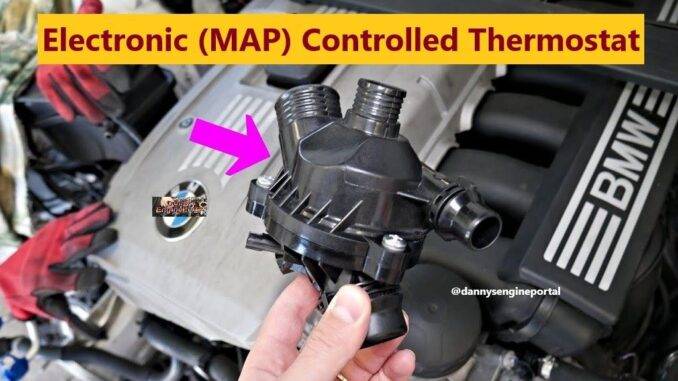
So, how do (MAP) controlled thermostats work. And, what are their benefits.
First, (MAP) controlled thermostats are electric, and are controlled by the engine’s (ECU).
Consequently, this provides precise regulation of the engines temperature, based on its needs.
Because, (MAP) controlled thermostats, provide broader and faster operation, than the traditional thermostat.
But, Conventional Thermostats, Can Only Respond To Changes In Temperature, Caused By:
- Heat From the Engine.
- And, Cooling From the Rad.
Electric Thermostats, Have Multiple Heat Ranges
(MAP) controlled thermostats generally operate, within two working temperature ranges. Both, are based on what the engine needs. Low to medium load, or high load and high speed.
This Is Where We Can See What That Means:
1. Low To Medium Load
With a low or medium load on the engine, they work exactly like traditional thermostats. But, they start to open at a higher temperature range. (between 100°C and 110°C,). This allows for a more efficient combustion process. And, ensures that “lower levels” of carbon monoxide and hydrocarbons, are released into the atmosphere.
2. High Load And High Speed
When the (ECU) detects an increase in engine load and speed, energy is applied to the heating element. That, causes (MAP) controlled thermostats to open earlier. Then, maintains a lower temperature in the coolant circuit. (between 85°C and 95°C,). This temperature drop improves the density of the air entering into the engine’s combustion chambers. As a result, enhancing engine performance, and preventing engine overheating.
This Level Of Temperature Control Provides:
- Optimum combustion, due to increased cylinder wall temperatures.
- Reduced fuel consumption, due to reduced viscosity of the engine oil and consequently, reduced frictional loss.
- Lower pollution emissions, due to improved combustion.
- Improved power output at full load, due to reduced coolant temperature.
- Increased comfort, due to higher coolant temperatures. As a result, improved interior heating.
(MAP) controlled thermostats, are maintenance free. And, are designed to last for the life of the engine. However, there are some external factors, that can lead to a material failure. For example, things like low grade coolant along with, failure to regularly service the coolant. Other possible causes of failure include, previous damage caused by thermal overloading or contamination.
(DTC) Codes, For Electric Thermostats
So, being able to see (DTC) code, when there is a fault, is an added feature. On these systems, the (ECU) knows if there is a problem. The (ECU) is able to determine, if there is a short or open circuit. It does this through measuring voltage drops, to determine if the circuit and components, are working normally. When the (ECU) detects a problem, it will set a (DTC) code.
The most common (DTC) codes are P0597, P0598 and P0599.
Possible Repair Procedures Include:
- Remove and inspect, the electrical connector. Remove any corrosion, using baking soda or by scraping. Apply electro grease and confirm, a tight connection.
- Inspect the coolant level, in the rad. Low levels of coolant will set a (DTC) code. As a result, of the thermostat overheating.
- Remove the electrical connector and check the resistance values, on the thermostat. For this procedure, you will need a service manual or the necessary information found online.
How To Test, (MAP) Controlled Thermostats
So, the first component to check, is the circuit. It is possible you may have a (DTC) code, for an open or short in the circuit. The first thing to do, is clear the (DTC) code. If the (DTC) code comes back immediately, you have confirmed the problem. If not, the problem, is in the heater coil or the circuit.
You can determine if the coil is bad, by measuring its resistance. Measure the resistance and compare, the specs in the service information. If you have no resistance, the heating coil is damaged. You can also use a multimeter to determine, if the (ECU) is sending voltage to the coil.
Conclusion
So, vehicle manufacturers are under intense pressure to produce cars and trucks, that produce fewer emissions. As a result, controlling the cooling system, is one way to do that.
BY DANNY BENDER




